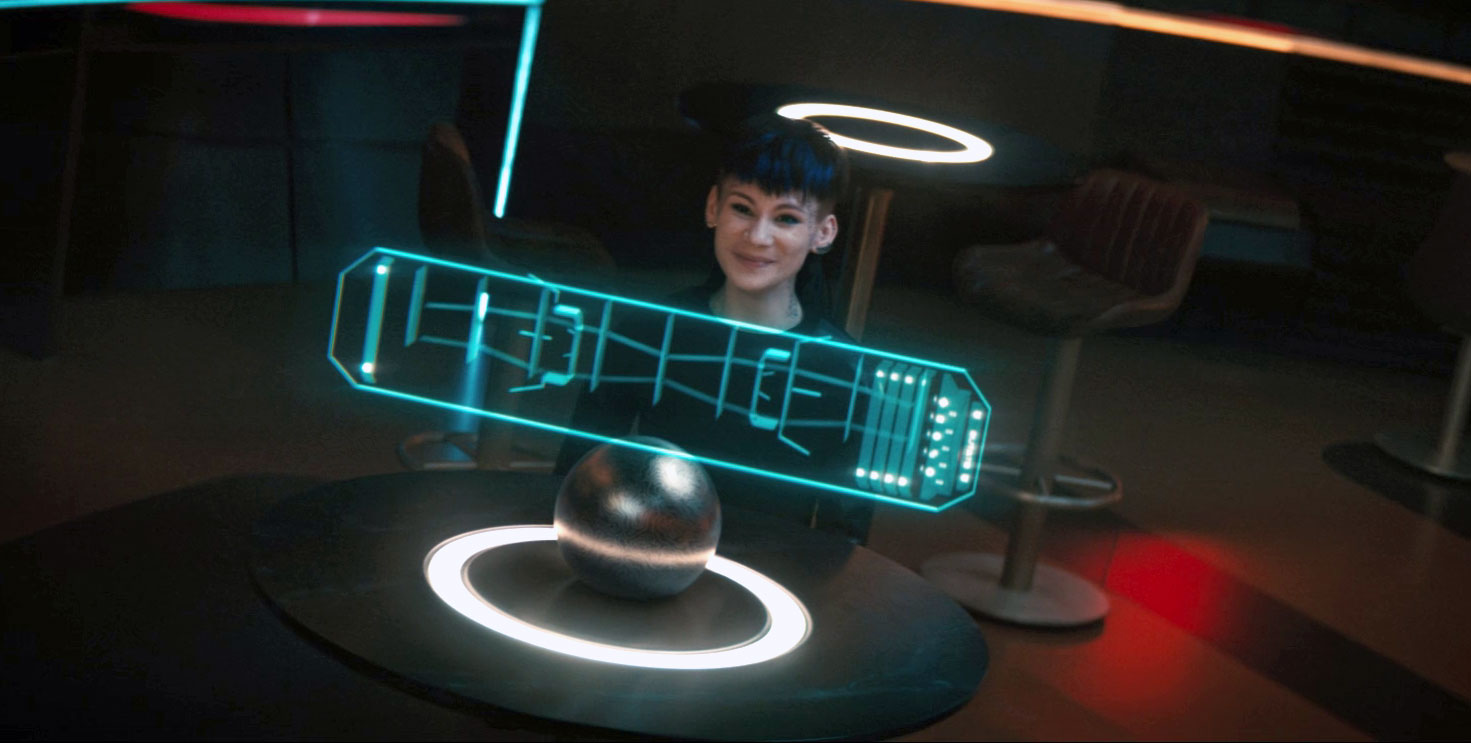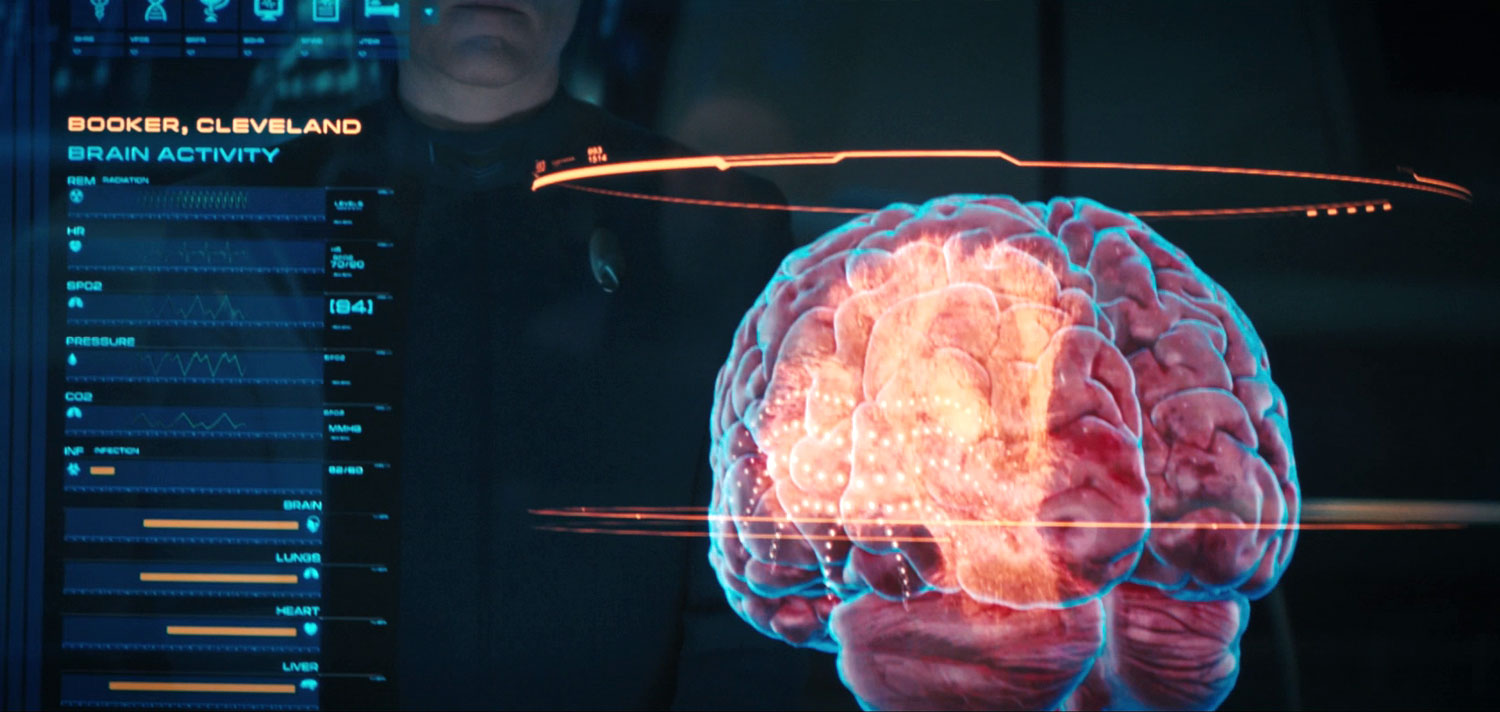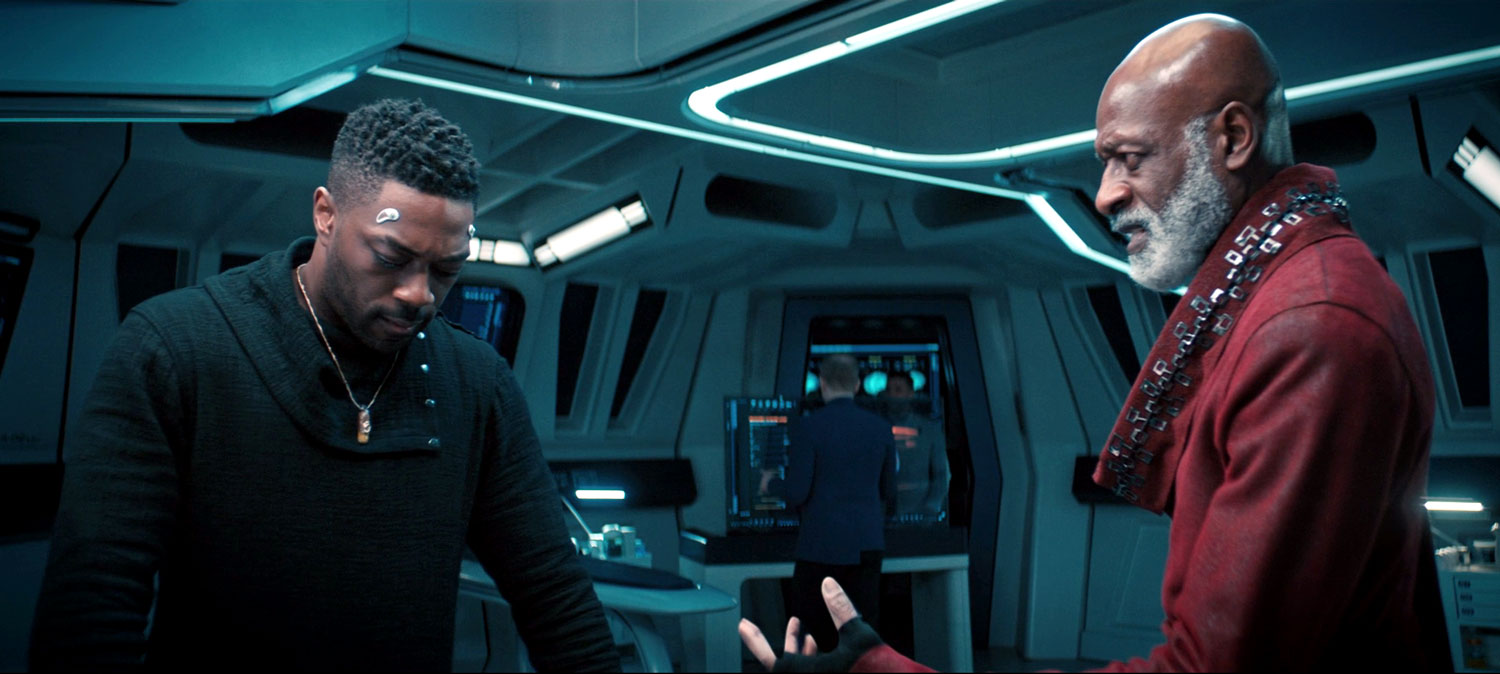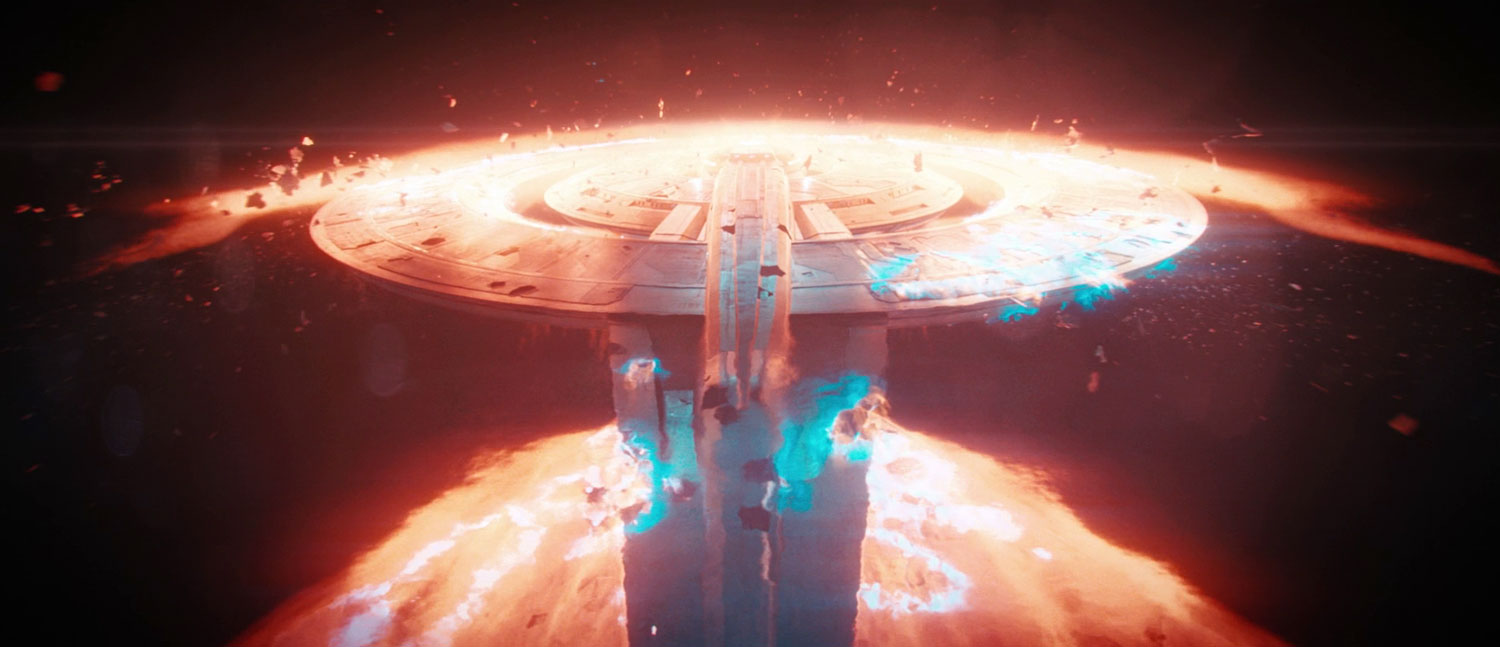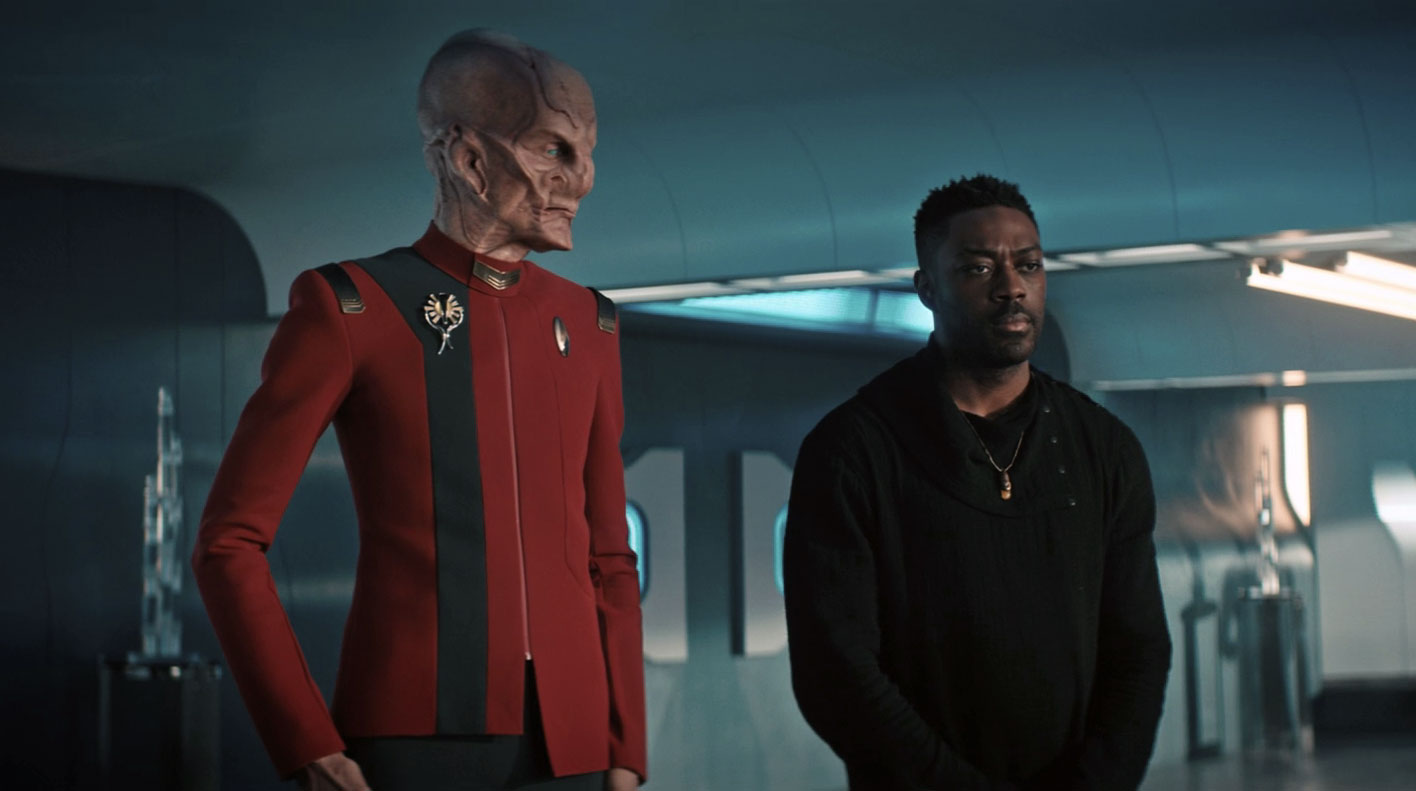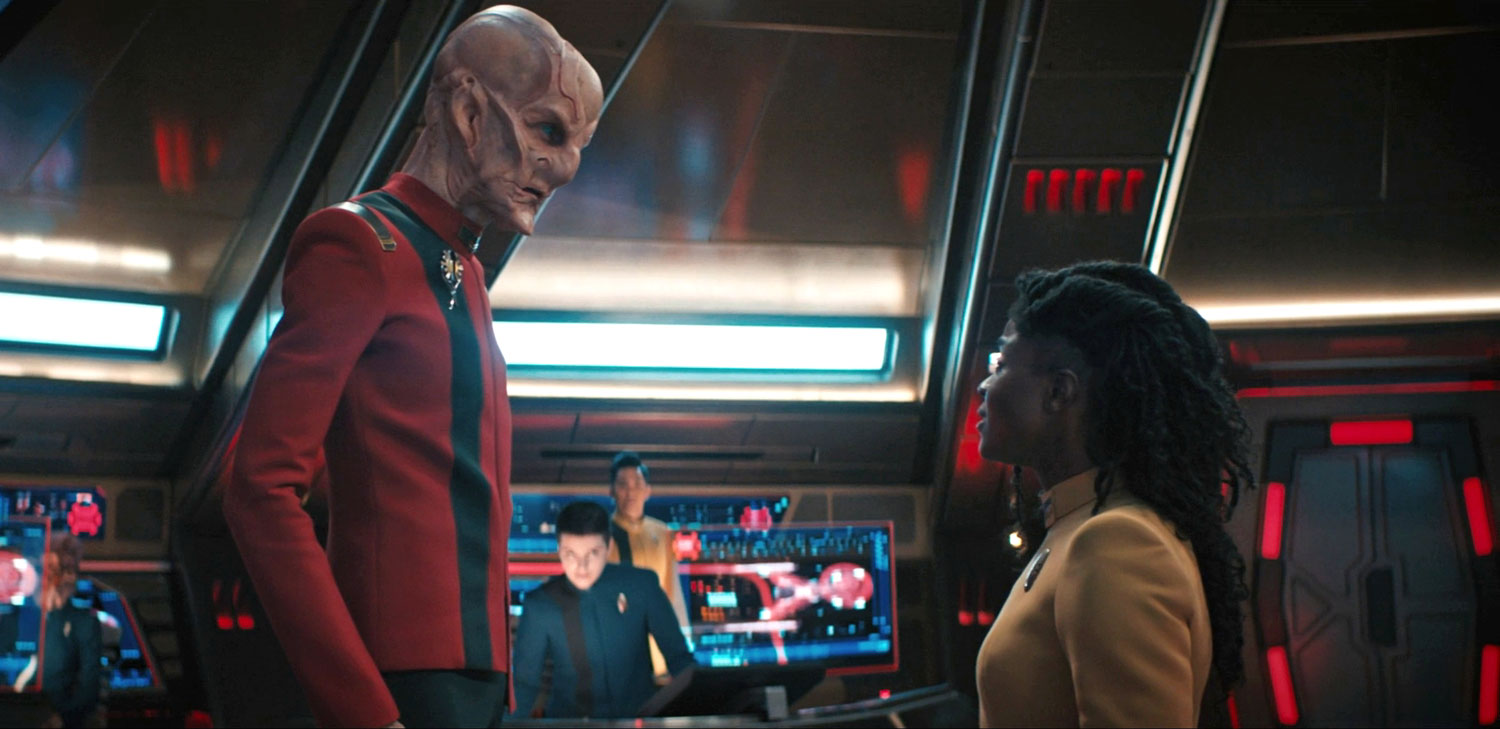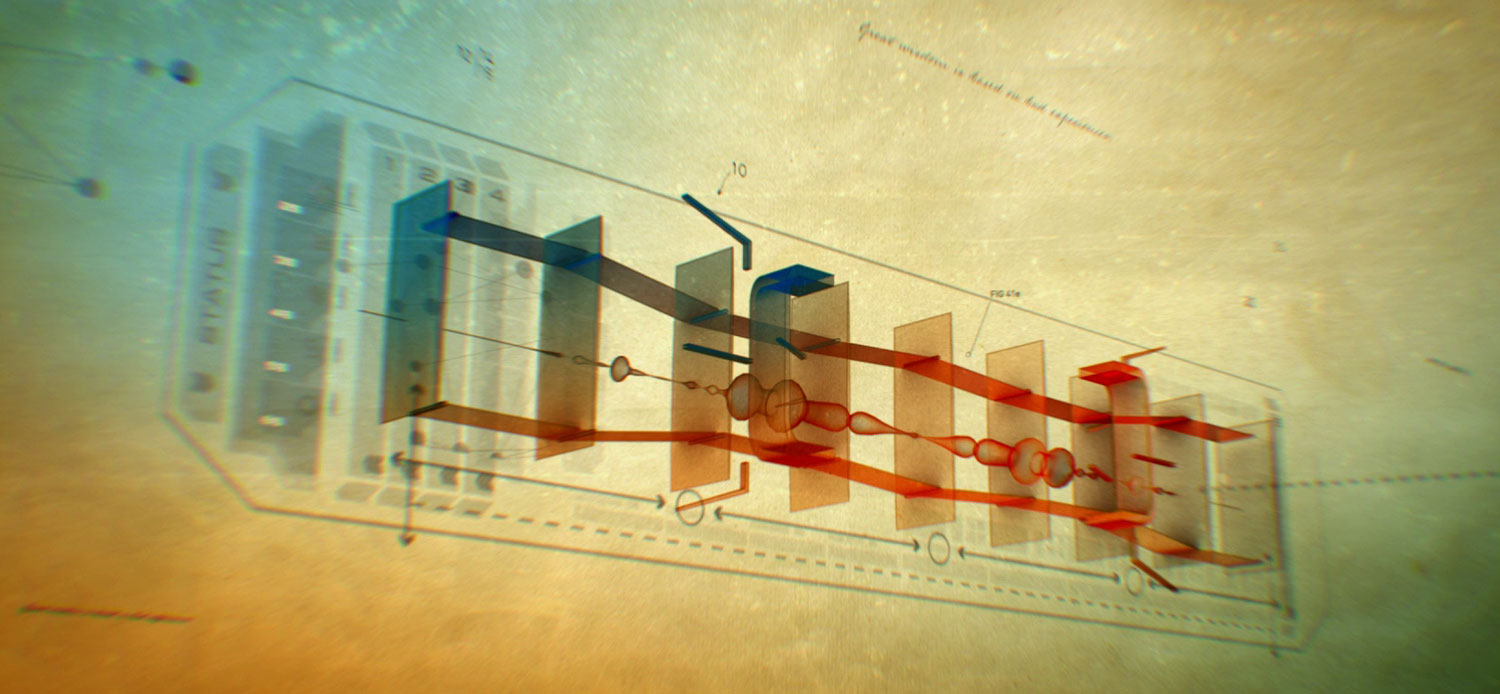In this week’s “Stormy Weather,” the USS Discovery crew explores a subspace rift left behind by the DMA, and finds themselves in uncharted — and unchartable — territory, as Zora’s newfound sentience calls to mind another famously-sentient computer from science fiction.
As part of the continuing quest for more data about the dark matter anomaly, and who might be responsible for it — after last week revealed the DMA is not a naturally-occurring phenomenon — Discovery is sent to investigate a subspace rift left in its path.
Upon entering the spatial tear, the crew unexpectedly find themselves in a completely featureless void. Reminiscent of Nagilum’s “hole in space,” the ship’s sensors pick up no data whatsoever, and there are no points of reference to navigate around the desolate expanse.
Even a robotic DOT drone sent out as a probe can only get a few thousand meters away from the ship before it begins to disintegrate. This rift is seemingly impenetrable, and more dangerous than any previously explored… and whatever “ate” the DOT is slowly closing in on Discovery itself.
This situation, one of external numbness and internal activity, plays havoc on the newfound sentience of Discovery’s computer Zora (Annabelle Wallis) in ways that immediately seem familiar. (Finally, the fact that I’ve seen 2001: A Space Odyssey more times than anyone really should has paid off!)
Zora’s story asks the audience to see her as a kind of anti-HAL 9000, as she speaks up as Burnham fills Saru in on the latest developments on Zora’s emotional growth. While the idea of Discovery having an ever-listening computer initially seemed a little ominous to me, in contrasting it with HAL’s silent eavesdropping on his ship’s crew, I realized Zora might be headed down a different path.
While HAL tries to distract Dave Bowman his suspicions about the nefarious computer through a game of chess in 2001, Gray (Ian Alexander) offers to play a game with Zora to calm her and help her focus on the situation at hand, in a nod towards the newly-resurrected Trill’s plan to become a symbiont guardian.
Because of Zora’s newly-emerged emotions, as well as the disturbing external sensory deprivation from being in a featureless void, the computer is overwhelmed by her awareness of the minutia of what’s going on inside the ship. Gray’s plan to help center Zora works, and she’s is able to make better sense of what she’s experiencing — even anticipating a deadly hull breach moments before it happens.
With only thirty minutes to go until whatever destroyed the DOT reaches Discovery, and no way of navigating a way out through normal propulsion, Captain Burnham (Sonequa Martin-Green) orders the one thing she was warned to avoid in this unpredictable location: a spore drive jump.
To ensure that Stamets (Anthony Rapp) can keep working on collecting data from the subspace rift, Discovery’s second spore drive pilot, Book (David Ajala) volunteers to take on the task — but the rift doesn’t want to let Discovery get away that easily, causing a violent energy surge to rip through Book while trying to initiate the jump.
Stamets manages to shut down the drive (after Discovery spins like a top for an uncomfortably long time!), and while Book seems to be physically okay, the energy surge has left him seeing hallucinations of his dead, estranged father.
In sickbay, medical scans reveal that strange particles from the rift have been temporarily lodged in Book’s brain — but those particles reveal vital new information about the DMA’s origin: it comes from outside the galaxy!
Those particles infecting Book’s mind are only found, it seems, in the massive galactic barrier surrounding the Milky Way — and as it passed into our galaxy, the DMA managed snag the particles from that glowing pink energy field introduced all the way back in 1966’s “Where No Man Has Gone Before.”
Though his hallucinations will subside after a few hours, they remain deeply unsettling: Books’ father questions his son’s life choices, repeatedly uses Book’s deadname “Tareckx” against his wishes, and sows doubt about his relationship with Burnham and his commitment to avenging Kwejian.
Even more disturbing, though, is the realization that these negative thoughts are likely Book’s own subconscious feelings towards his place in life, especially after the trauma he’s suffered this season.
Back on the bridge, the crew brainstorms ideas on how to navigate out of the rift and decides a plan to send out a signal which will essentially give Detmer (Emily Coutts) a ‘sonar ping’ to follow out of the rift — before the ship gets eaten by ‘toxic’ subspace.
In a fun moment that emphasizes just how far into the future Discovery now is, Bryce (Ronnie Rowe, Jr.) has to explain sonar to Adira (Blu del Barrio); it’s such an archaic technology from their perspective that they’ve never had reason to hear of it.
Unfortunately, there simply isn’t enough time for Detmer to do this before the encroaching rift’s edge will impact the ship, making it impossible for the crew to survive in the disastrous onboard conditions — but in a truly unexpected and inspired callback to TNG’s “Relics” and Voyager’s “Counterpoint,” Saru (Doug Jones) suggests that the crew takes refuge in the transporter pattern buffers during the perilous flight, waiting to rematerialize until after Discovery has safely exited the rift.
It’s a good (if unorthodox) idea, and the crew quickly locks down the ship and beams up into transporter stasis — everyone, that is, except Captain Burnham, who is determined to ride out the escape, and to keep the nervous Zora company along the way.
Burnham’s EV suit provides a little extra protection from the punishing temperatures, and she uses the time to talk Zora through the fear she expresses as the digital being feels parts of her body dying — to make another 2001 comparison, contrast this with HAL’s fear at feeling his “mind going.”
Even so, Burnham isn’t going to be able to remain conscious through the entirety of the four-minute (and extremely cool-looking) journey, and places all of her trust in Zora to wake the crew when they reach safety — again, compare this to HAL who killed his crew as they lay in cryosleep.
In return as a gesture of comfort and thanks, Zora offers to sing Burnham a song (the eponymous “Stormy Weather”) as the captain struggles to remain conscious as the bridge bursts into flames.
The song is an odd, heavy-handed offer, but it’s also the ultimate expression of Zora as anti-HAL. While from an entertainment perspective, the rendition of “Stormy Weather” wasn’t really my thing, I have to appreciate it as a literary device; it’s a deliberate mirror of HAL singing “Daisy” to Dave Bowman as he destroys HAL’s sentience.
Zora has proven herself to be trustworthy and caring where HAL very much did not.
The episode closes with Saru demonstrating that once again, he is Discovery’s philosophical compass. I certainly don’t want to diminish Dr. Culber’s formal training, or his role as ship’s counselor, but as shown as Saru helps Book work through the anger he continues to feel, the Kelpian really is the person to come to for compassionate, caring wisdom.
In his time on the Kaminar Council, Saru has had to learn to work peacefully with the Ba’ul members despite his own unpleasant past with others of their kind — including the culling of his parents and community, and in doing so, he’s had to examine his own emotions.
Saru’s final words of wisdom to Book also echo Zora’s struggles with her at times overwhelming emotions: “We’re both justified in our anger. Allowing it to be our focus, however, only prevents us from achieving those things which serve the greater good.”
OBSERVATION LOUNGE
- Saru references prior encounters with a subspace rift from Starfleet records, indicating that an Enterprise noted “heated plasma” and a Voyager charted “ionized particle eddies” — though while it’s unclear which version of each starship he’s referring to, the Voyager encounter may be a reference to the anomaly seen in “Real Life.”
- This week’s moment of Random Supporting Character Facts! comes from Owosekun (Oyin Oladejo), who tells Saru that a friend of hers died when she was younger, which seems to be meant to explain her outburst regarding the lower-deck hull breach earlier in the episode.Saru thanks her for the information and then placidly beams himself away.
It’s so abrupt — even for one of ‘these’ moments — that I have to wonder if a line or two of additional dialogue was cut out. At this point I can’t decide if I hate these moments (or am weirdly endeared to them), but either way their continued presence is just so bizarre.
- I’m happy to see that the Trek tradition of sticking medical doohickeys onto people’s foreheads is still alive and well in the 32nd century, even if the things themselves have been significantly downsized from the big chunky cortical stimulators of the TNG era.
- According to Zora, the name she chose for herself means “dawn” or “new day” in the languages of various cultures learned about, including some languages on Earth, on Ni’Var, and of the Ba’ku society seen in Star Trek: Insurrection.
- Through Zora’s new holographic waveform “presentation,” we know know she’s been seen in the opening credits all season.
Throughout the episode, Zora expresses a lack of confidence in her ability to perform and stay focused — so much so that at one point, Burnham and Gray take a private moment to talk Zora through her fears. Her newly emerged emotions are overwhelming, as is her awareness of the sheer quantity of information she’s processing at any given moment as the ship’s computer.
This is a perfectly reasonable reaction to have to a sudden awakening — both of sentience and of emotional complexity — but I do wonder how Zora’s status as a being with agency will intersect in the future with the rigid functional requirements of a computer. A ship that hesitates on something as uncontroversial as a navigational heading because it lacks confidence seems, well, less than ideal.
I hope that whatever the solution is, it’s beneficial to both Zora and the crew’s ability to rely on the ship as the functional and responsive spacecraft it needs to be. Perhaps an artificial body for Zora similar to Gray’s would be a good solution?
Wherever Zora’s path leads this season, whether it to be the “Calypso” story or otherwise, it’s clear that there’s still a lot to address when it comes to life as a sentient starship — both for her, and for the Discovery crew.
![]() Star Trek: Discovery returns with “…But to Connect” on December 30 on Paramount+ in the United States, and on CTV Sci Fi Channel and Crave in Canada. Outside of North America, the series is available on Paramount+ and on Pluto TV in select international locations.
Star Trek: Discovery returns with “…But to Connect” on December 30 on Paramount+ in the United States, and on CTV Sci Fi Channel and Crave in Canada. Outside of North America, the series is available on Paramount+ and on Pluto TV in select international locations.

